Andy does Jewish Music
First, there is no such thing as
Jewish
music, any more than there is Christian music or atheist
music.
There is music, and there are uses for music, so when I say
"Jewish Music," I mean "music in a Jewish context."
I became Bar Mitzvah in
Mt. Clemens, Michigan, in a small Orthodox synagogue, Beth Tephilath Moses.
My stepfather, an Air Force Officer, was stationed at Selfridge AFB,
and this synagogue was the only one within practical
distance of base housing.
My mother didn't like it,
but I enjoyed very much attending cheder and
learning to read and write Hebrew with Rabbi Aaron
Brander.
The kiddush menu following my Bar Mitzvah was
bread, pickled herring, honey cake, and whisky.
|
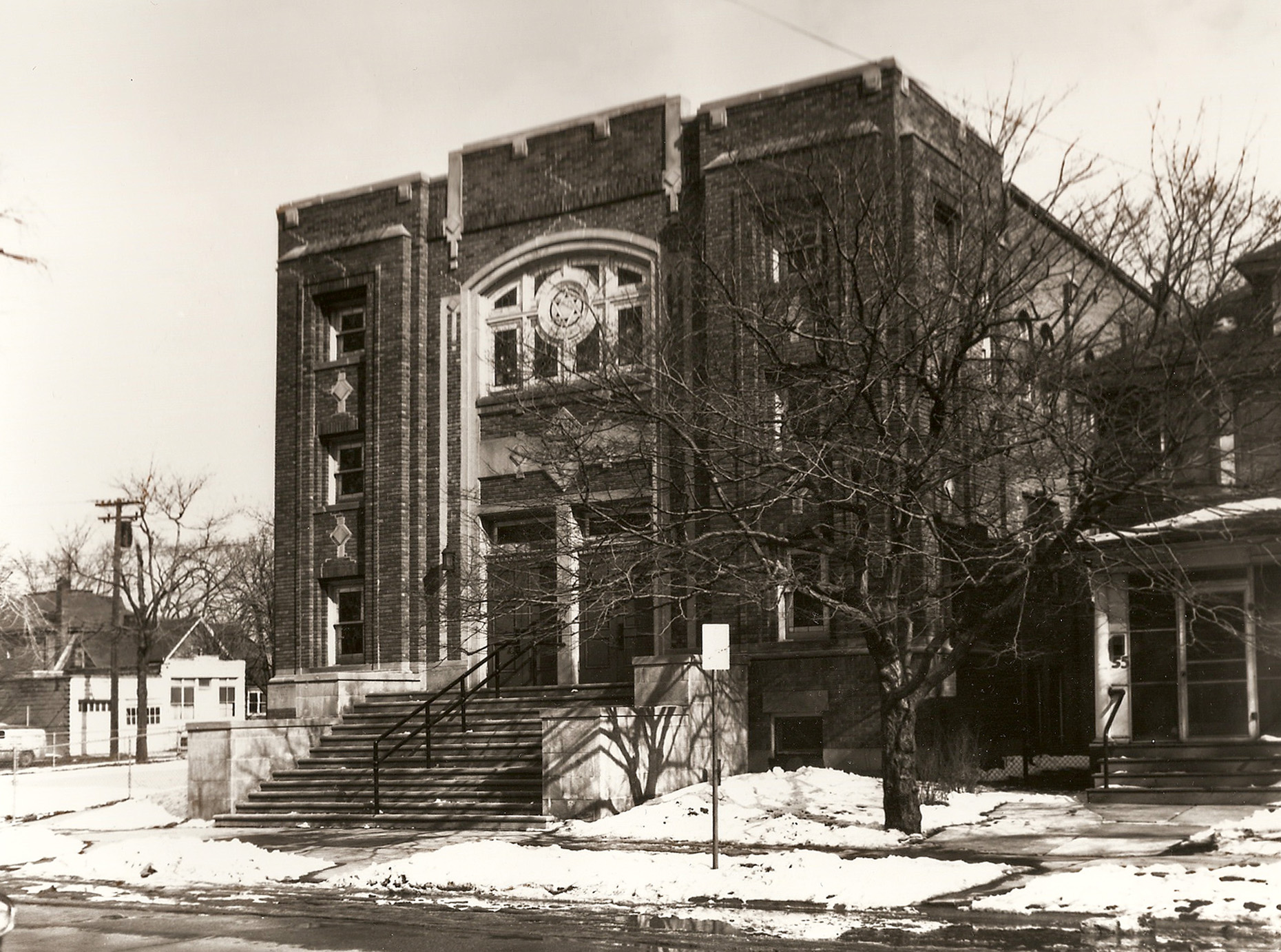
|
For about the next 25 years, I hardly gave religion a second
thought; I was busy with other things.
My first wife, a lapsed Catholic, wanted to attend a Jewish
service, so one Friday night in 1989 we went to
Temple B'nai
Jehudah in Kansas City.
To my surprise, I liked it - a lot.
Many of the melodies I hadn't heard for years came back to me, and
I found I could still read Hebrew to some extent.
We attended some more services, and
Cantor Paul Silbersher z"l* and his
accompanist,
Myrna Braverman z"l, recognized that I could
sing.
We joined the synagogue, and I joined the choir.
A couple of years later,
Rabbi Gerald Kane z"l, the Education
Director, asked me to teach Sunday school, 5th grade.
I accepted, which meant that I actually had to learn some stuff in
order to teach it.
Not music, but maybe an interesting story:
Someone donated a large Winnebago RV to Temple B'nai Jehudah
in 1993.
Rabbi Michael Zedek asked me if I
would use that vehicle, rechristened "The Winnebagel,"
in outreach to the unaffiliated. I drove it to various
sites - including Lawrence - armed
with bagels and drinks, waiting for the curious to come
aboard and talk religion.
Sometimes I would convince a rabbi to come along.
It was a flop in terms of popularity, but out of it grew an
adult Torah-study group, led by me,
that met in an actual building and read through all of the Chumash,
the five books of Moses.
|
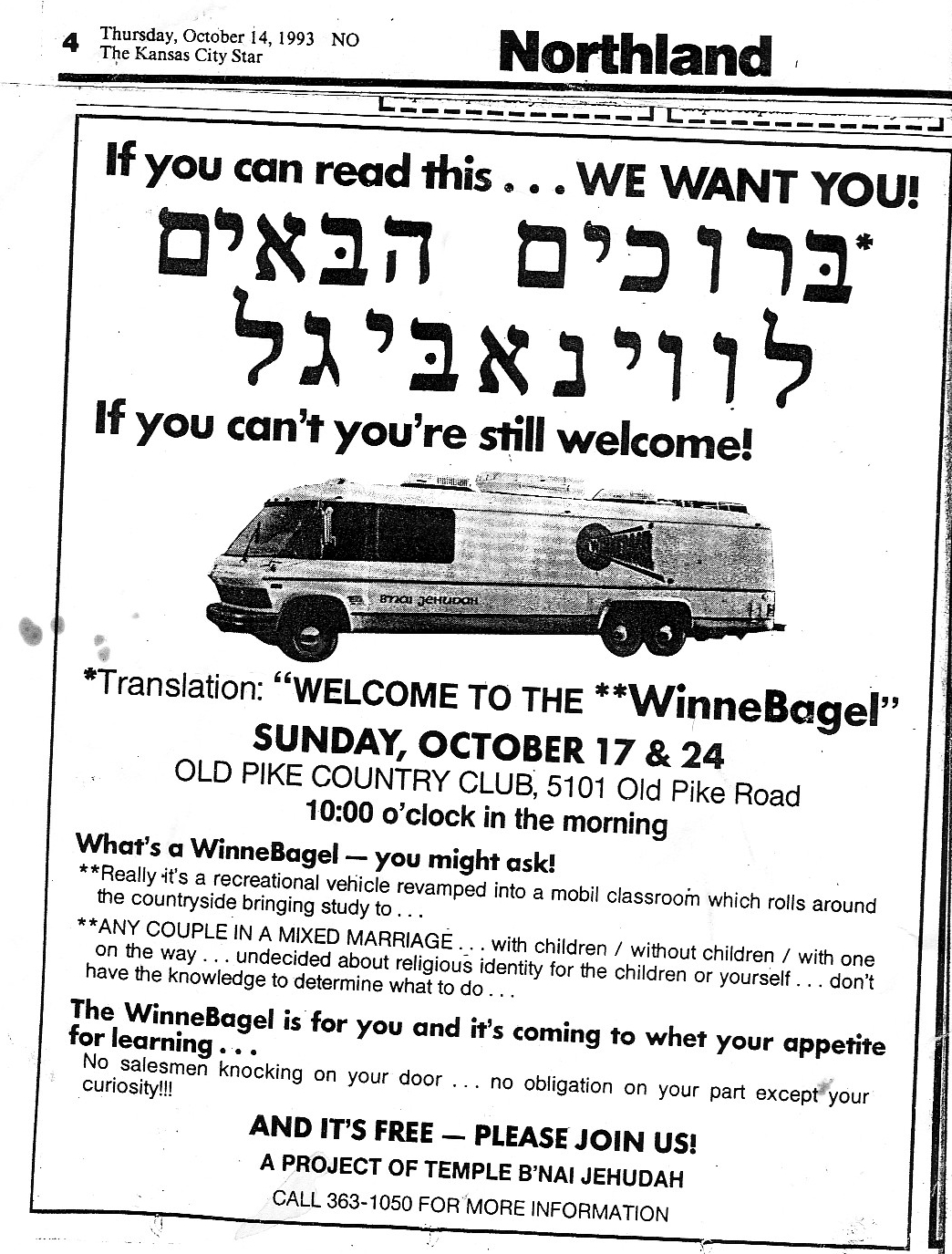
|
In 1995, I became the Sunday school's music
teacher/songleader.
I played songs like "Tzena Tzena," "Shalom Chaverim," and "Yesh
Lanu Tayish" for the younger grades,
led school-wide morning worship, and mentored older kids who were
interested in songleading.
That same year, I was hired to lead High-Holyday services at
Temple Beth El in Sedalia, Missouri.
Beth El was a dying (Reform) congregation comprising a few elderly
folks, mostly women. It still used the
Union Prayer Book
II, revised in 1955.
That turned out to be a good thing for me, because the services
were mostly in English and there was not a whole lot of music
involved.
I remember hearing of the O.J. Simpson verdict on my drive to
Sedalia for the Kol Nidrei service.
Beth El folded in 2001.
Around this time, I had a fertile period of songwriting:
One God - kind
of sixties-ish anthem, a little reminiscent of the Rascals'
"People Got to Be Free." Off of the Nigun Orchestra album.
Run, Rabbi, Run!
- this Chuck-Berry-flavored number is about the demands made on
congregational rabbis.
Al Tira Avdi Yaakov -
"Fear not, My servant Jacob". The text is from a Havdalah
acrostic piyyut I found in the Artscroll Siddur. I set it
to music while preparing to lead havdalah for a wedding party.
Under the Rug -
this song is what you might call tragicomic. One of my
best, I think.
Bread! - another
Pesach-based song, built around how we Jews come to miss bread
during Passover. I'll have to redo this one sometime
without the heavy echo on my voice.
Ani Omed
L'hitpalel - stolen from the old gospel shout song
"Standing in the Need of Prayer" as performed by the Country
Gentlemen. I just translate some verses into Hebrew...
Hamapil - a musical setting
of the bedtime blessing.
Shavuot - music from Buddy
Holly's "Take Your Time", words about the mysterious holiday of
Shavuot.
Leshev Basuka - "to
dwell in the sukkah." About the pleasures of outdoor
living during the festival of Sukkot.
Avot - a gloss on the opening
blessing of the Amidah, combining English and Hebrew. It's
pretty much for children in a Reform setting, but Rabbi Cohen
and Rabbi Kane both loved it.
Thanks, God! - a
gloss on the "bathroom blessing."
The Hammer Came
Down - a song about the fatal flaw - hubris - of Antiochus
Epiphanes, the bad guy of the Chanukah story, and karma.
In 1997, I was playing and singing in
renewal services at both B'nai Jehudah and
Beth Shalom,
usually in a group with Devra Lerner (whom I
knew from childhood in Wichita!) and Linda Salvay.
As those two played guitars, it gave me an opportunity to play the
bass.
Devra and Linda were far more familiar with the world of Jewish
music than I, so it was a good learning experience for me.
The services at Beth Shalom were branded "Tefillah 2000" -
an ill-advised moniker given that 2000 was not far off.
We kept this informal group going until around 2005, when Devra,
Linda, Myrna Braverman, and others formed their own group "
Yachad - the Traveling Tefillah Band."
That year,
Rabbi Stuart Davis, who usually led
High-Holyday services at Fort Leavenworth, asked me if I would
take that "gig" one time only.
I said yes and put a great deal of [misguided] effort into
preparing. I produced my own
machzor (high-holyday
prayerbook), wrote sermons, and hired an accompanist.
I think I went "over the top" for a group of Army officers and
their spouses, most of whom would have preferred something lighter
... but "wasted effort" is often not really wasted.
Three noteworthy things happened in 1998.
Devra Lerner and Linda Salvay convinced me to go to Hava Nashira. It's
a week-long summer camp in Oconomowoc, Wisconsin where
song-leading Jews go to be with others and learn, sing,
worship, and share.
At that time, the faculty included such luminaries as Jeff
Klepper, Debbie Friedman z"l, Craig Taubman, Danny
Maseng, and Ellen
Dreskin. Some of the campers, notably Billy Jonas and Rick Recht, have gone on to some
notoriety in their own right.
A highlight for me was being asked by Craig Taubman to
present one of my songs, "Al Tira Avdi Yaakov" (above), in a
large song session. There are too many lyrics in that
song for me to remember, so I sang instead one of my
Sunday-school songs, "Thanks, God!" (above). It went
over well, and Judy Caplan Ginsburgh recorded it on a
CD which won a 2003 Children's Music Web Award as the "Best
Religious/Inspirational Recording for Preschoolers."
Another highlight was learning "Ki Va Moed." Although
I didn't know it at the time - I don't recall it's being
mentioned - that was my first real exposure to the music of
Shlomo Carlebach, a true giant of
Jewish music and "neochasidism" in the 20th century and
beyond. We played and danced to this song, as well as
Taubman's L'kha Dodi.
The photo to the right shows me playing during unstructured
time at Hava Nashira.
I'm wearing a tee shirt I got from a retreat led by Rabbi Amy Wallk, who was
assistant rabbi at Beth Shalom in Kansas City at the time
and also taught (superbly)
in the Melton School.
I attended again in 1999.
|
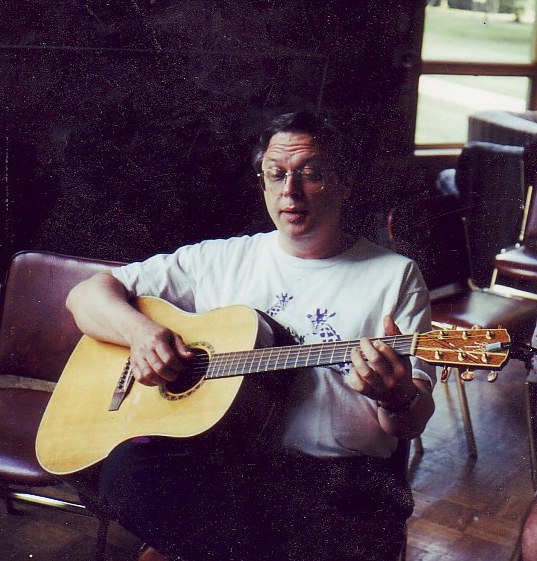
|
I was hired to be the cantor for High-holyday
services in Columbia, Missouri. I got the job by
sending a recording of me singing some of the liturgy and by
meeting Rabbi Yossi Feintuch at a Mexican restaurant in
Columbia.
At that time, Columbia's Congregation Beth Shalom did not
have its own building, so services were held in the Hillel
House at the University of Missouri.
In 2000, we held services at the First Baptist Church (see
photo at right), and thereafter until the congregation
bought land and built its own building.
I've gone back every year since - 24 years
as of this writing - so I guess I'm
doing okay.
The rightmost photo captures services in 2021,
when we met outside due to COVID-19.
Rabbi Phil Cohen served as interim
rabbi after
Rabbi Feintuch left the congregation in 2018.
|
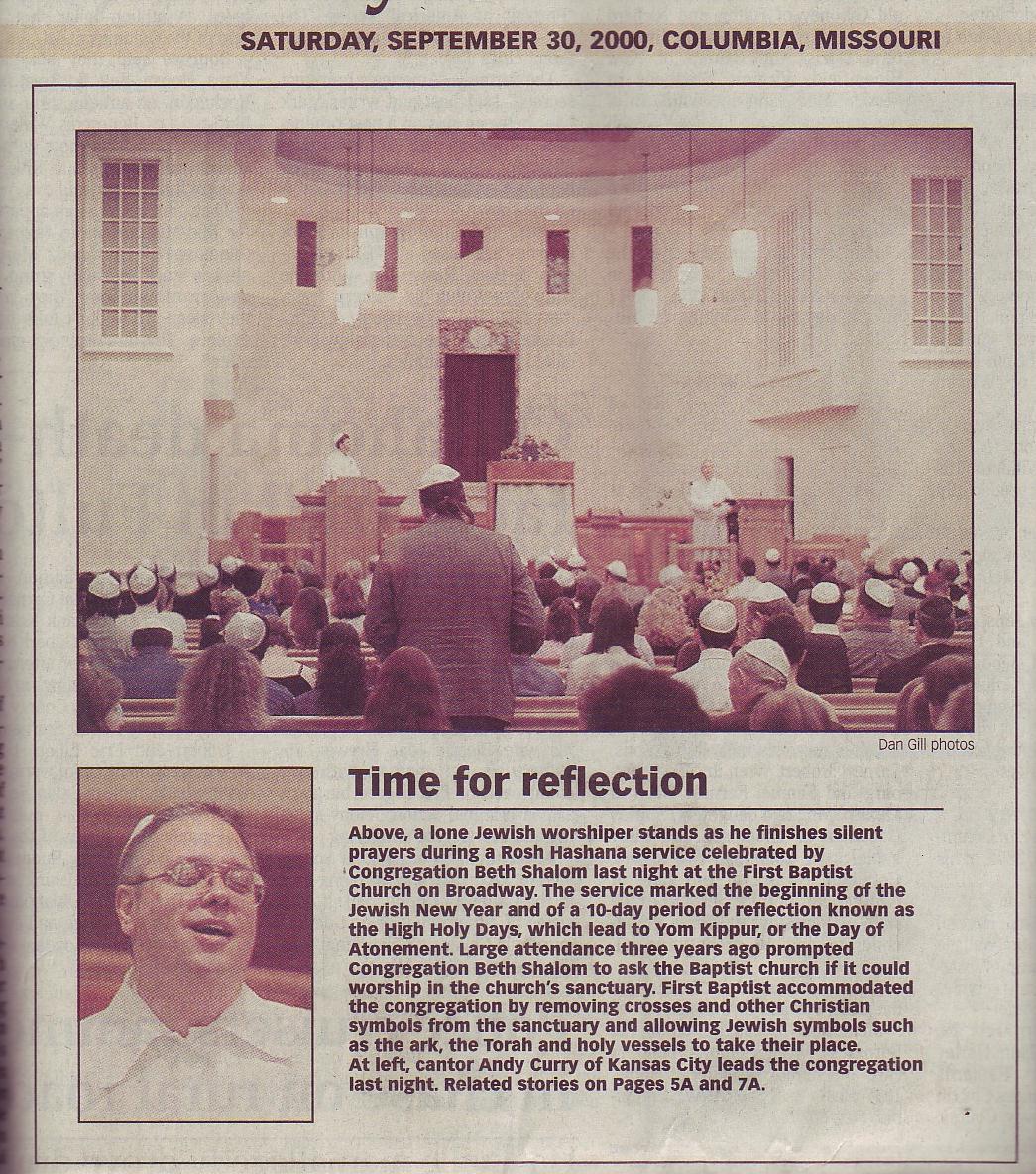
|
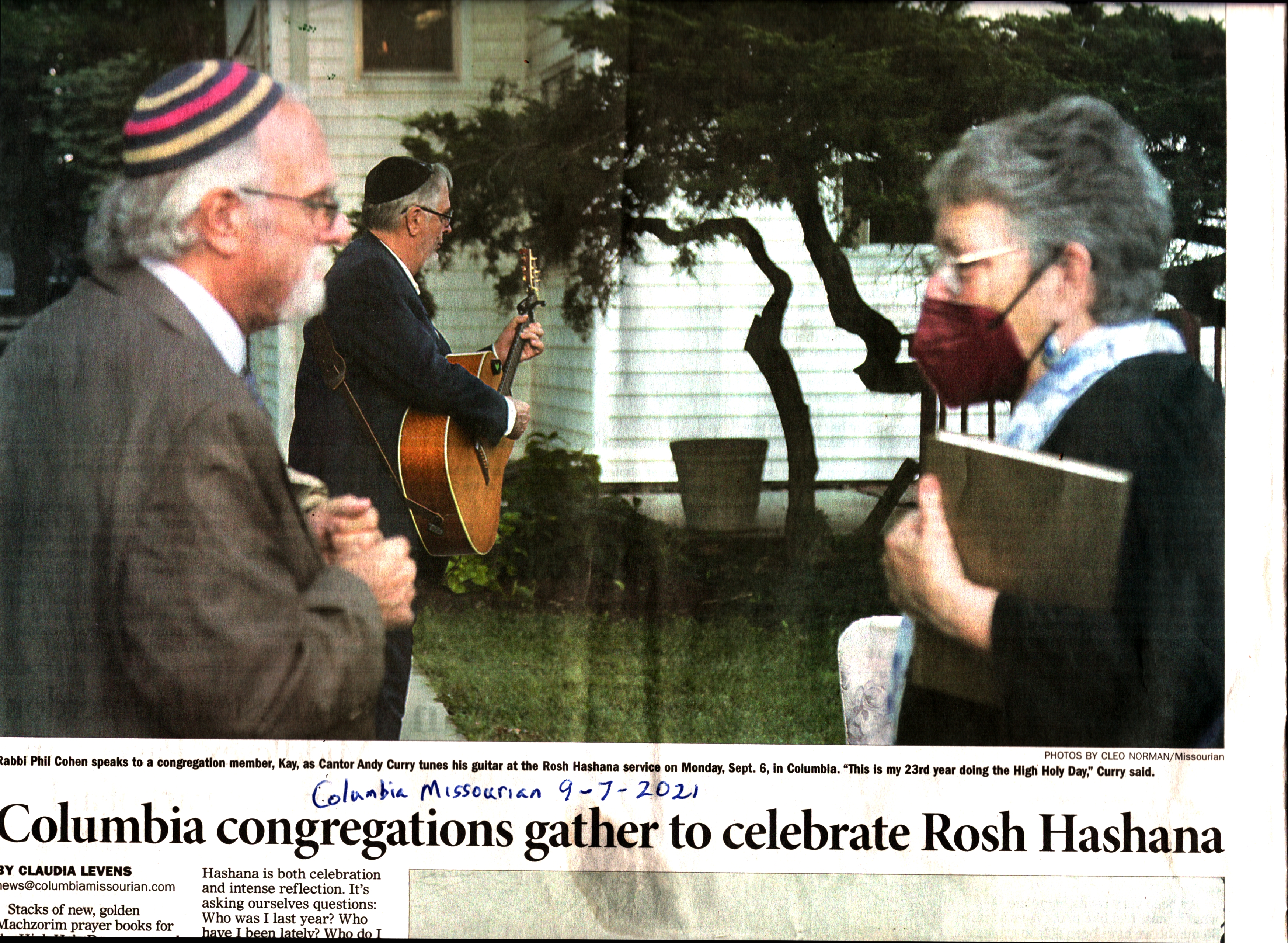
September 2021.
|
In my role as B'nai Jehudah religious-school
songleader, I led the little kids in a couple of songs for
Simchat Torah. Following the rituals, a local Jewish
band called
the Nigun Orchestra
played for dancing. The bandleader, Mel Prezant,
apparently liked what he saw/heard in me and later invited
me to join the band as its guitarist.
There is a whole page, accessible by clicking on the link
above, devoted to the Nigun Orchestra. That page
includes some cuts from our 2004 album.
|
My last year as Sunday-school songleader was 2000 -
which was also
when B'nai Jehudah began its move from 69th & Holmes in
KCMO to
124th & Nall in Overland Park.
There was also a wholesale turnover in clergy. Rabbi
Zedek, Rabbi Kane,
and Cantor Silbersher all left for other venues.
Despite its dated 1960s architecture -
some called it the "Cecil B. DeMille sanctuary," and one of
the rabbis,
when asked how many the sanctuary would seat, replied "It
sleeps 700" -
the Holmes Road building held many dear memories for me.
It's gone now.
The photo at right depicts one of my last functions
involving B'nai Jehudah,
April 2000.
|
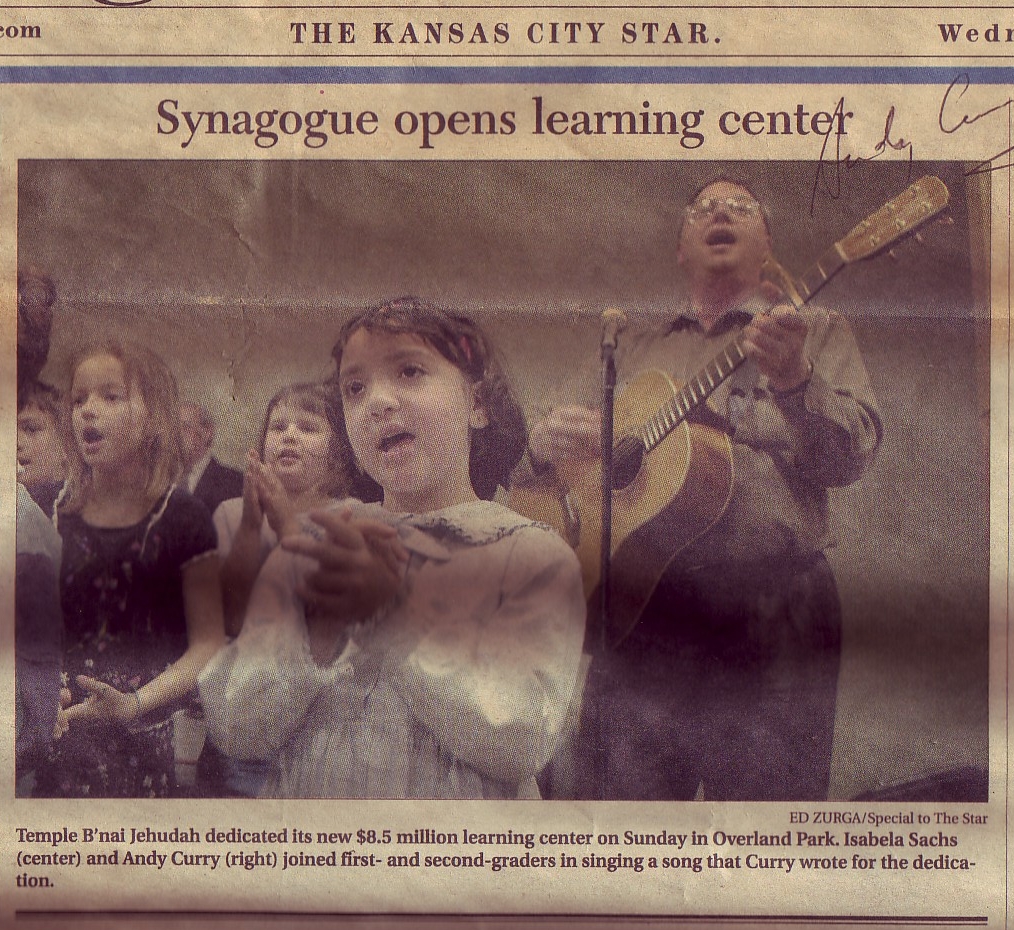
|
The early 2000s saw me get involved with the
formation of a choir of sorts, a Jewish vocal group called
Shireinu.
As happens with
many bands, the
Nigun Orchestra disbanded in 2005, after
completing our album.
BelleAnne and I formed a group - The
L'chaim Players - with pianist Lori Levens
and woodwind-player Harold Steinhardt.
*****
Meet Me in St. Louis!
In 2006 and 2007, I was having real trouble
becoming and staying employed in my day career.
I took a contract in Nashville for the state of Tennessee; my
brother-in-law, Rick Yord,
helped me find a room in the home of Mike O'Neill, a drummer and studio owner
whom Rick had played with in the past.
It was expensive and stressful to commute between Kansas City
and Nashville,
so when a "headhunter" called to ask if I'd be interested in a permanent
job in St. Louis, I said YES.
I interviewed, got the job, and we picked up stakes and moved in
August of 2007.
Part of moving to a new place is searching for and selecting a
place to worship.
We went "shul shopping" and decided to join two
congregations: Congregation B'nai Amoona and Traditional Congregation.
Traditional Congregation is a relatively
small congregation affiliated with the Union for
Traditional Judaism (UTJ). It is served by a single
rabbi,
Rabbi Seth Gordon, with no cantor.
The services are, well, traditional, and the
ambience is friendly and informal.
I enjoy davening there - the full canonical
liturgy, with no nonsense.
Shortly after joining (2008), BelleAnne and I were asked
to lead music for Purim. It was then that I
discovered a cultural difference between St. Louis and
Kansas City:
In Kansas City, people were paid for playing and singing
in synagogues;
the reaction I got when I asked for a small payment was a
little as though I had dropped a turd in the punchbowl.
We were paid, though, and after our performance
the woman who had hired us called and said "I didn't
realize you were so good - you were worth it!"
Purim 2008 ->
|
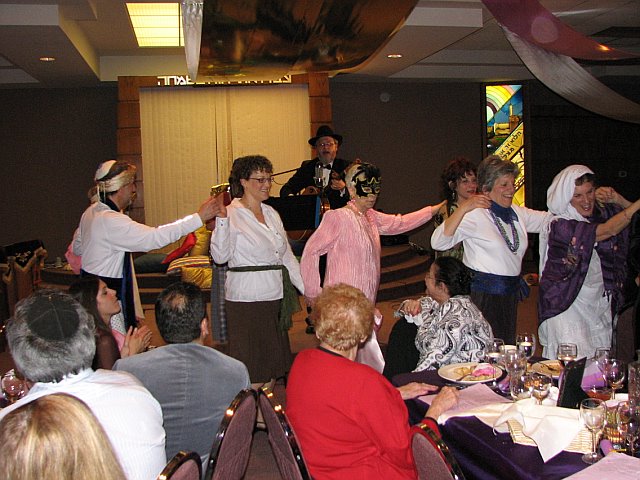
|
B'nai Amoona, a much larger
congregation, is affiliated with the United Synagogue for
Conservative Judaism (USCJ).
It is egalitarian - women are fully enabled in ritual - so
BelleAnne prefers going there.
She has learned to read Haftarah, and she and I lead
Sunday-night services together.
Cantor Nathanson often asks the two of us to join her during
Shabbat morning services as well, because we're "harmony in a
can."
In 2016, I was designated "Composer in Residence" for B'nai
Amoona.
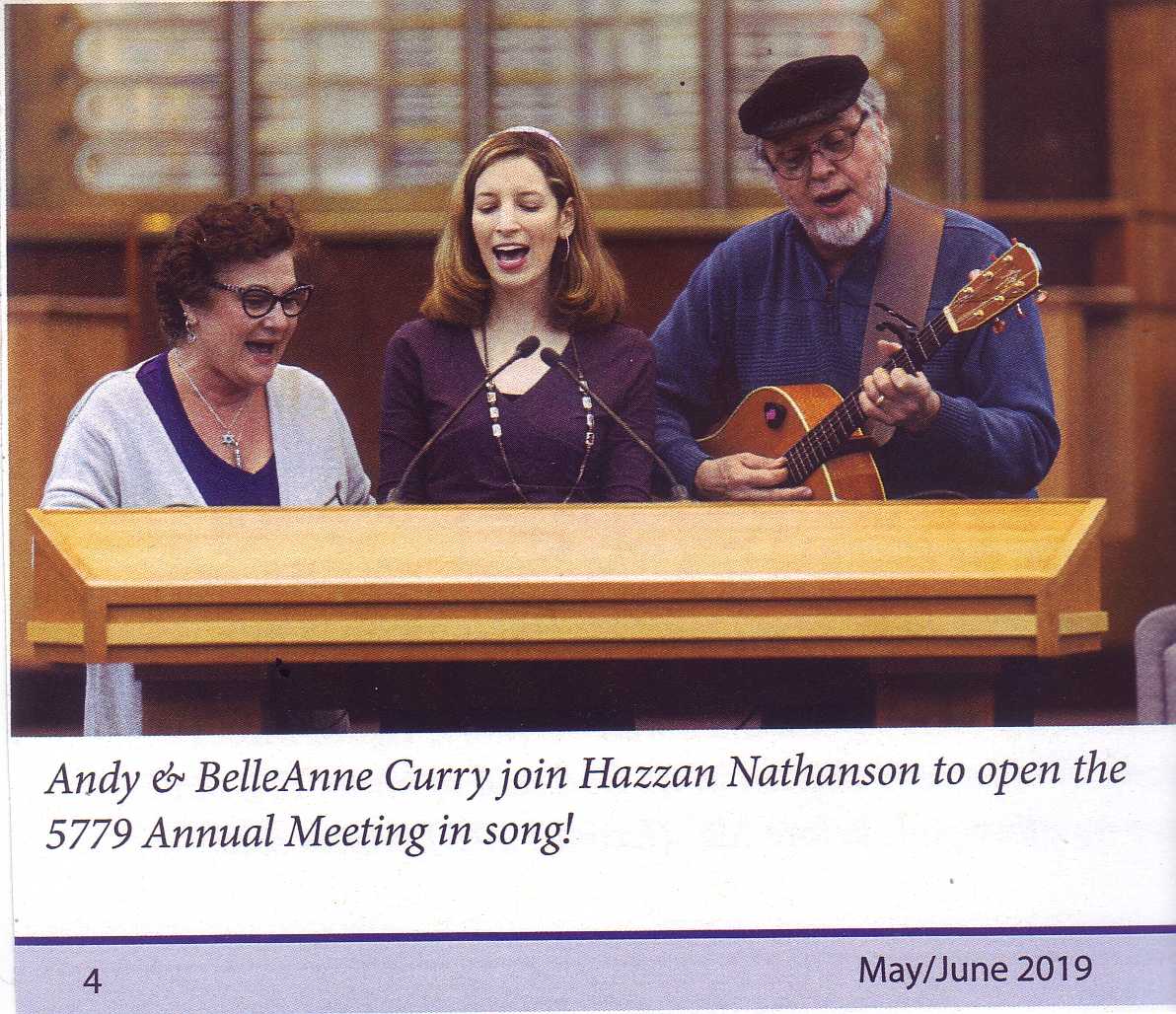 In February 2021, I was the musical director for a
virtual concert (yeah, COVID) featuring
"Cantor Nathanson and Friends."
In February 2021, I was the musical director for a
virtual concert (yeah, COVID) featuring
"Cantor Nathanson and Friends."
In 2014, I was invited to join a Jewish men's a capella singing
group, Meshorerim.
The group was formed in 2008 by Fred Blumenthal, who earned his
Ph.D. in Musicology and was for a few years a music reviewer for
the St. Louis Post-Dispatch.
Meshorerim is a Hebrew word which usually refers to the
men and boys who would assist and accompany cantors in "olden
days."
Members of the group included Dr. Andy Youkilis, Nick Riggio,
Howard Granok, Mark Krug, Rabbi Josef Davidson, Jay Englander,
Barry Seeskin, Mark Silvermintz, and me.
Fred Blumenthal wrote/arranged most of our material, but I
contributed as well,
most notably in arranging a full Shacharit service for men's
voices, which we performed at Shaare Zedek, Traditional
Congregation, and B'nai Amoona.
As with so many other things, COVID-19 put an end to Meshorerim.
I've been blessed also to collaborate with some
(other) very talented Jewish-music people in St. Louis,
notably
Will Soll
and
Eitan
Kantor.
* z"l is short for Zikhrono livrakha or
zikhrona livrakha, meaning "may his/her memory be for
blessing," and connotes that the named person is no longer living.
Copyright 2022 by Andy Curry







